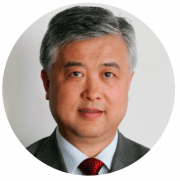What motivated you to make your naming gift to USC Viterbi in 2006?
MH I was grateful I was able to study at an engineering school as wonderful as USC’s. I always wanted to pay something back to the school that educated me.
In 2010, you made another large gift to USC to create the Ming Hsieh Institute for Research on Engineering-Medicine for Cancer. What is your vision for the institute?
MH I envision integrating our engineering knowledge and technology with the life sciences to help fight cancer, this very deadly and costly disease. There is tremendous benefit by integrating engineering technology with life sciences in trying to build better treatment programs and better diagnosis of the disease. From the engineering side there’s data mining, cloud computing, signal processing and genomics in the life sciences — there’s really so much data to be analyzed. Beyond that, the institute could help integrate the engineering campus with the medical campus to solve the problems together.
Your newest company, Fulgent Therapeutics, is involved in cancer drug development and research. Tell me a bit about the firm and its mission.
MH We currently have two companies. One is Fulgent Pharma, which is developing nanotechnology based on cancer-drug therapeutics. Nanotechnology can better control drug release and offers targeted, guided drug delivery. The other is Fulgent Genetics, which provides flexible and affordable genetic testing that improves the everyday lives of those around us.
Are you optimistic that somebody will cure cancer in the next 25 years?
MH I think we’ll definitely make much, much more progress. I think even in the next 10 years there will be tremendous change, especially when you consider the current [trend of] precise and personalized medicine.
How do you feel USC Viterbi prepared you for your career success?
MH What I learned at USC — the environment, the spirit and collaboration with classmates and friends — changed my life. I’ve worked with a lot of USC graduates and students at my companies over the years. I started my first business with a couple USC friends. My most recent company, Fulgent, I helped create with my friend An Yin’s younger brother, Ray Yin. He was a graduate student in the USC chemistry department. I knew both of them at USC in the 1980s.
Where do you see USC and USC Viterbi in the decade to come?
MH In the past 10 years, both USC and USC Viterbi have made tremendous improvements. That’s especially true in our electrical engineering department with the continued support of some alums and the leadership of our dean, Yannis Yortsos, and our president, Max Nikias. USC’s name will continue to be ranked among the best.
In 2015, you were elected to the National Academy of Engineering. How do you feel having obtained the highest honor an engineer can receive?
MH That was a tremendous honor and surprise. I was humbled to receive such recognition from my peers. Really, it inspired me to do more. I want to make a meaningful impact, especially with cancer genetic research and diagnostics.
Your son was born around the same time as the electrical engineering department naming. Do you see him one day studying here?
MH My son Jeremy loves USC. He’s nearly 10. He will always grow alongside our department. He was born on Oct. 24 at 4 a.m., just a day after the naming ceremony. At the present time, Jeremy loves computers and he loves gaming, and I think USC Viterbi has one of the best gaming and computer science combination programs in the country.




